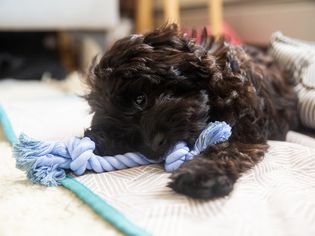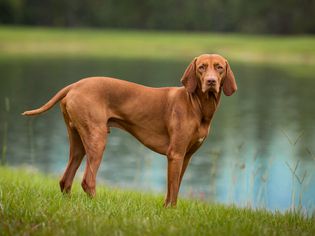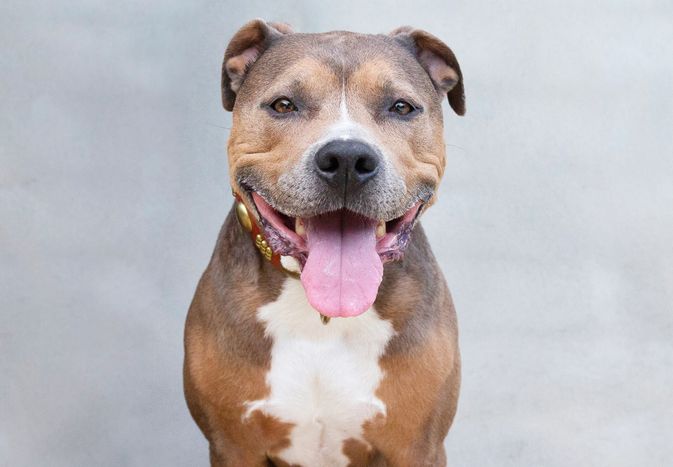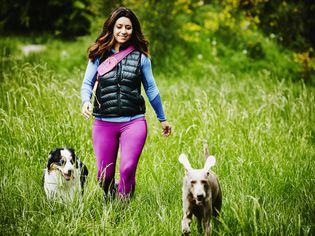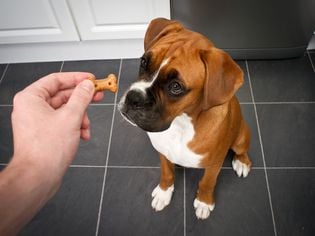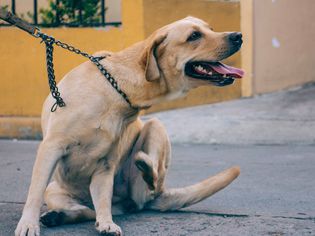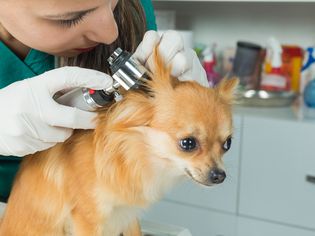The otterhound is a large English hound breed with long ears, a sturdy build, webbed feet, and signature shaggy fur. They love swimming and have a strong sense of smell for hunting. This breed is also incredibly rare (less than 1,000 in the world).
The first time you see this adorable dog, you might mistake them for a doodle or another mixed breed, but the otterhound is actually a breed all its own. It's believed that these dogs date back to medieval times in England when they were prized for their otter-hunting skills. Today, these large and lovable hounds are full of energy and always ready for fun.
Learn more about the history of the otterhound, as well as their temperament and care needs.
Breed Overview
Group: Hound
Height: 24 to 27 inches
Weight: 80 to 115 pounds
Coat: Dense, rough, coarse topcoat; short, wooly, slightly oily undercoat
Coat Color: Black, gray, tan, wheaten, black and tan, liver and tan, blue and cream
Life Span: 10 to 13 years
Temperament: Friendly, bright, energetic, even-tempered, boisterous
Hypoallergenic: No
Origin: England
Characteristics of the Otterhound
Since they're such a friendly breed, otterhounds make great family dogs and companions for active households. Their play-driven temperament is a good match for older kids, and their high energy level makes them a great dog for active people who want to bring their pup along on hikes, bike rides, and runs; however, they should not be allowed off-leash.
An otterhound's hunting instincts can override even the best obedience training, and like all hound dogs, the desire to follow their noses can get them in trouble. As long as your otterhound is safely kept on a leash or in a fenced-in yard (assuming the fence is tall enough), this dog can quickly become your best friend thanks to their lovable, silly personality.
| Affection Level | High |
| Friendliness | High |
| Kid-Friendly | High |
| Pet-Friendly | High |
| Exercise Needs | High |
| Playfulness | High |
| Energy Level | High |
| Trainability | Medium |
| Intelligence | Medium |
| Tendency to Bark | High |
| Amount of Shedding | Medium |
History of the Otterhound
In 18th-century England, hunting with hounds was a big pastime. Although fox hunting was the most popular at the time, otter hunting was also common. It was born of necessity as river otters decimated fish populations, which were a valuable food source for humans.
Otter hunting, like fox hunting, eventually became prevalent as a sport. Noblemen and royalty, including Queen Elizabeth I, raised otterhounds. Otter hunting was banned in England in the 1970s because otter populations were severely depleted.
Otterhounds were raised to hunt in large packs of dogs. Since squabbles among packmates would interfere with getting the job done, otterhounds were bred to be even-tempered. These dogs typically get along well with everyone—including kids, strangers, other dogs, and even cats—and are especially affectionate toward their family members.
Today’s otterhound is thought to have a variety of breeds in their background, including bloodhounds and various shaggy French hounds. The otterhound is very rare. According to the Otterhound Club of America, there are fewer than 1,000 otterhounds in the entire world; most of them are in the United Kingdom and the United States.
Otterhound Care
While they're a very desirable dog for the right person, the otterhound can be a bit high-maintenance when it comes to care. This breed needs plenty of exercise along with consistent training to be their best. Grooming requires a bit more than some other hound breeds, but thankfully, their signature shaggy coat doesn't need to be trimmed.
These dogs aren’t recommended for apartment or condo living due to their large size and exercise needs.
Exercise
The otterhound needs plenty of exercise to stay happy and well-behaved at home. The younger an otterhound is, the more exercise they need, but at least one to two hours per day is a good starting point.
Reserve extensive exercise for when your dog turns two years old to allow the bones and joints to develop fully. After that, good activities include:
- Long walks
- Hikes
- Jogging
- Swimming
- Playing fetch in safe, enclosed areas
Otterhounds should never be allowed to roam freely. They tend to follow their noses when they catch a scent and may ignore your commands or not pay attention to dangerous situations like traffic. Always keep your dog safely on a leash or inside a privacy fence, as this breed is prone to jump—and their large size means they can easily bound over shorter fences.
Grooming
The otterhound’s medium-length, tousled coat is a trademark feature of the breed. It doesn’t require trimming, but weekly, thorough brushing is necessary to keep the coat from matting and to cut down on shedding (but luckily, they shed only moderately).
Otterhounds have an oily, waterproof undercoat. While it's a major bonus for swimming, it can also lead to a greasy-feeling outercoat and doggie scents. Some otterhounds have more oil than others; how often they need to be bathed depends on how the coat looks, feels, and smells.
The shaggy beard collects water and food, and it can also develop an odor if not kept clean. The attentive dog parent should dry the beard frequently and wash it during regular baths.
The otterhound’s big, hairy paws may also track in dirt and mud, so it can be worthwhile to keep a towel handy near the door to wipe them down before coming inside. Trim the nails weekly and clean the ears with a pet-safe ear cleaner as needed.
Training
Otterhounds can be challenging to train, so it's best to start basic obedience training when your hound is a puppy (around 8 weeks of age). This is not because they aren’t smart—you just need to figure out what motivates them.
Otterhounds have sensitive personalities, so gentle methods like clicker training and positive reinforcement work best. Otterhounds respond best to praise and especially food rewards. Start training your dog young before they grow large and strong enough to pull you off your feet.
Keep training sessions short and upbeat, and provide lots of consistency in what you expect of your otterhound. With enough friendly encouragement, your dog will grow up to be well-behaved and happy.
Although otterhounds are loving and happy-go-lucky, they're also strong. Their boisterous nature could lead to them inadvertently knocking over small children, so carefully supervise all kid-and-dog interactions involving this breed.
Common Health Problems
The otterhound is fairly healthy, but like most purebred dogs, is predisposed to developing certain hereditary health conditions.
The following are common conditions associated with the otterhound breed:
- Hip dysplasia: This condition is caused by a malformation in the hip joints as the dog ages.
- Gastric dilatation-volvulus (bloat): Like many large and giant dogs, otterhounds can develop this condition affecting the stomach. Bloat consists of gas buildup that causes the stomach to twist, which can be fatal. Preventative surgery during puppyhood is often recommended by veterinarians.
- Glanzmann thrombasthenia (GT): This potentially fatal bleeding disorder can affect otterhounds. Owners must take precautions to prevent dogs from injuries.
Responsible breeders will test their dogs for hip dysplasia and GT before breeding to avoid passing on problems. When buying an otterhound puppy from a breeder, be sure to ask for paperwork confirming these tests were performed on the parents.
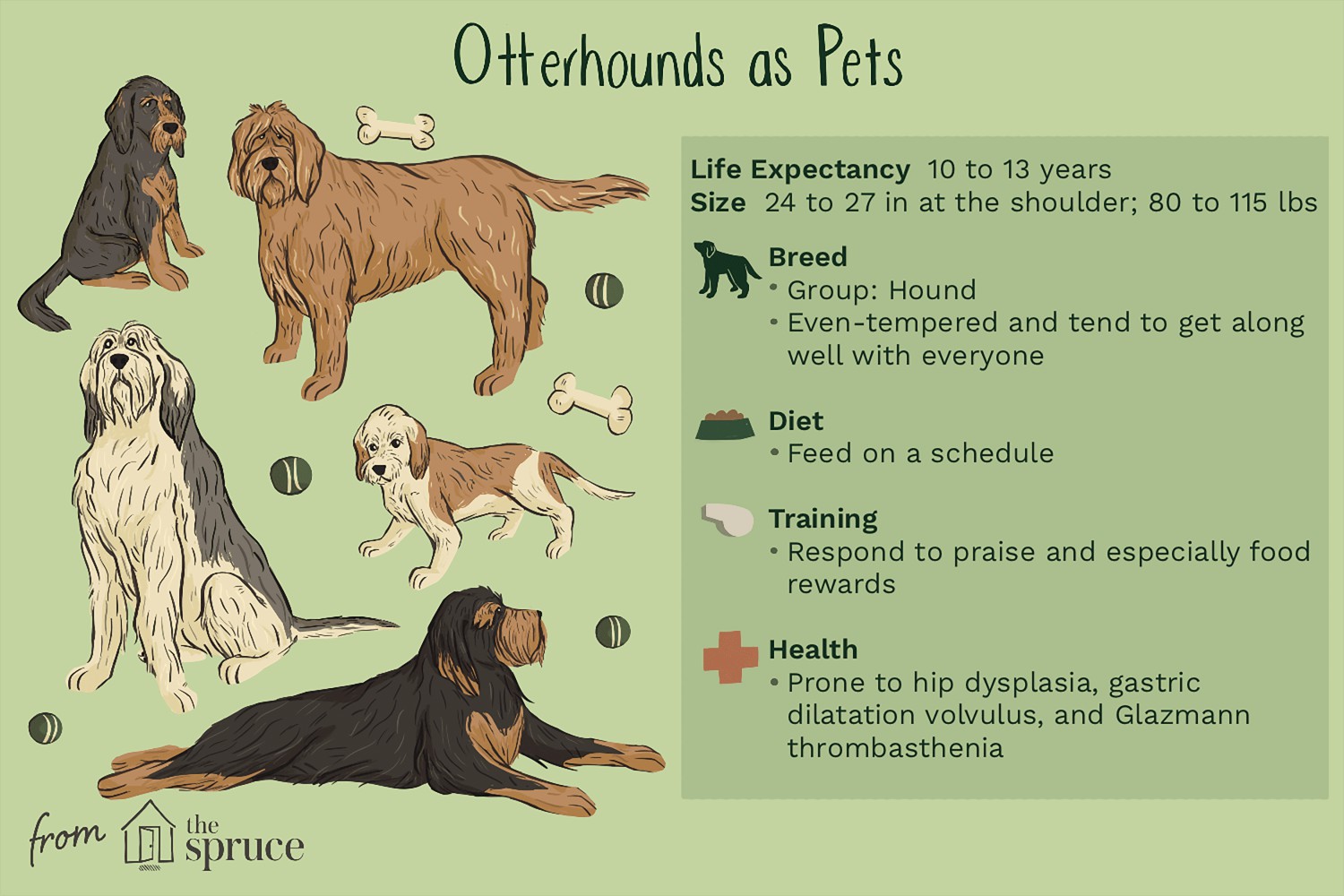
The Spruce / Emilie Dunphy
Diet and Nutrition
Feed your otterhound on a schedule (morning and evening for adults) and measure out precise amounts of high-quality dog food with a measuring cup or scale. Since this is a large dog breed, it's important to avoid overfeeding. This can cause bloat, and over time, canine weight gain can contribute to hip dysplasia.
Talk with your veterinarian to determine a healthy eating schedule based on your dog's age, weight, and activity level.
Where to Adopt or Buy an Otterhound
If you're set on adopting an otterhound puppy, start your search by researching responsible breeders. Ensure you can view the medical history of the litter's parents and see the conditions they live in. These puppies typically cost about $1,500 to $3,000, though prices can vary depending on pedigree and availability. Responsible breeders don't breed often, so prospective adopters should be prepared to join a waiting list.
Since the otterhound is such a rare dog breed, it's not common to find one in shelters. However, breed-specific rescues are a great place to find otterhounds in need of their forever homes. Many similar hound breeds can also be found in local shelters, so consider meeting the dogs in your area to find your new best friend.
These resources for the national breed club, rescues, and the AKC are a great place to begin:
- The Otterhound Club of America Rescue
- The Otterhound Club of America Breeders
- AKC Otterhound Breeders
Otterhound Overview
Otterhounds are great family dogs. They can be a little messy, so they might not be the best breed for the clean freaks, but if you can live with a little mud, hair, and drool, the clownish otterhound will make you laugh and be your constant companion.
Pros of Otterhounds
- Lovable and affectionate
- Gets along with children and other pets
- Great companion for active families
Cons of Otterhounds
- Needs considerable exercise and training
- Grooming must be consistent to prevent doggie smells
- Rare breed that is hard to find
More Dog Breeds and Further Research
If you love the otterhound, you might also like these similar breeds:
- Goldendoodle
- Old English Sheepdog
- Portuguese Water Dog
There are plenty of different dog breeds that can join your family. With a little research, you can find your own perfect match!
- Are otterhounds good family dogs?
Friendly and affectionate towards kids, strangers, and other animals, otterhounds can make excellent family dogs for the right people. Since this breed requires extensive exercise to stay well-mannered and healthy, they're best for active individuals who don't leave their dogs alone often.
How rare is the otterhound?The otterhound is a very rare dog breed that can be difficult for potential adopters to find. According to the AKC and the Otterhound Club of America, there are fewer than 1,000 otterhounds in the world.
How much do otterhounds cost?You can expect to pay a breeder $1,500 to $3,000 on average for an otterhound puppy.

